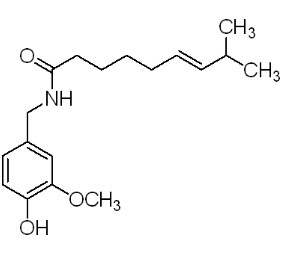产品中心
中药标准品
|
产品编号 |
英文名称 |
CAS号 |
包装 |
|
Y3709 |
Capsaicin |
404-86-4 |
可根据客户要求订制 |
产品编号:Y3709
英文名称:Capsaicin
CAS号:404-86-4
分析标准品,≥95%(HPLC),
分子式 C18H27NO3 分子量305.41 密度 1.041
熔点 62-65°C
存贮条件 储存温度 2-8°C

基本信息:
描述
别名 辣椒碱 ;天然辣椒素,(E)-N-(4-羟基-3-甲氧基苄基)-8-甲基-6-壬烯酰胺 ;E)-N-[(4-Hydroxy-3-methoxyphenyl)methyl]-8-methyl-6-nonenamide
生化机理
Description:
IC50 Value: 150 M (MTT assay in FaDu cells) [1]
Capsaicin is the active component of chili peppers, which are plantsbelonging to the genus Capsicum. Capsaicin, as a member of the vanilloidfamily, binds to a receptor called the vanilloid receptor subtype 1 (VR1). Capsaicin is able to kill prostate cancer and lung cancer cells by causing them to undergo apoptosis.
in vitro: Treatment of A172 cells withcapsaicin inhibited cell growth and induced apoptosis through down-regulation of Bcl-2 and activation of caspase-3. Interestingly, synergistic induction of morphological alternation was observed when A172 cells were treated with capsaicin [2]. After the addition of capsaicin, the levels of reactive oxygen species were reduced slightly in the earlier stage of treatment. Interestingly, an elevation of intracellular calcium ion concentration was detected in the MCF-7 cells [3].
in vivo: Intraperitoneal administration of CAP (10mg/kg body weigh
分析标准品,≥95%(HPLC),
分子式 C18H27NO3 分子量305.41 密度 1.041
熔点 62-65°C
存贮条件 储存温度 2-8°C
描述
别名 辣椒碱 ;天然辣椒素,(E)-N-(4-羟基-3-甲氧基苄基)-8-甲基-6-壬烯酰胺 ;E)-N-[(4-Hydroxy-3-methoxyphenyl)methyl]-8-methyl-6-nonenamide
生化机理
Description:
IC50 Value: 150 M (MTT assay in FaDu cells) [1]
Capsaicin is the active component of chili peppers, which are plantsbelonging to the genus Capsicum. Capsaicin, as a member of the vanilloidfamily, binds to a receptor called the vanilloid receptor subtype 1 (VR1). Capsaicin is able to kill prostate cancer and lung cancer cells by causing them to undergo apoptosis.
in vitro: Treatment of A172 cells withcapsaicin inhibited cell growth and induced apoptosis through down-regulation of Bcl-2 and activation of caspase-3. Interestingly, synergistic induction of morphological alternation was observed when A172 cells were treated with capsaicin [2]. After the addition of capsaicin, the levels of reactive oxygen species were reduced slightly in the earlier stage of treatment. Interestingly, an elevation of intracellular calcium ion concentration was detected in the MCF-7 cells [3].
in vivo: Intraperitoneal administration of CAP (10mg/kg body weigh


